by Emese Krunák-Hajagos
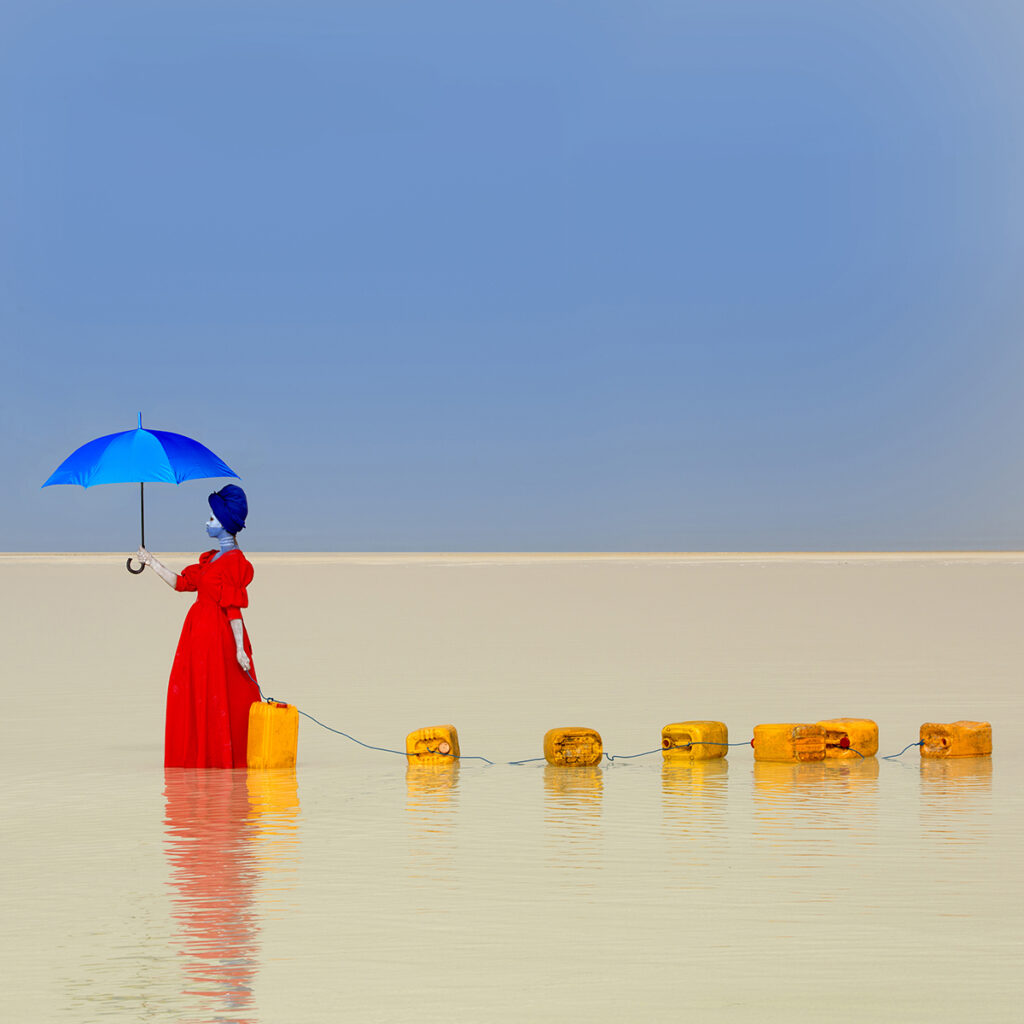
Water is life. For those of us who have clean water in abundance, it is hard to imagine what life would mean without it. The lack of clean water overshadows the entire life of women living in countries without it, as it is their responsibility to provide water for the household.
Ethiopian born Aïda Muluneh chose water as the theme for her exhibition at the Textile Museum of Canada, capturing many aspects about the lack of it and how it determines the lives of women and girls, both ecologically and socially, even limiting their access to education and, as an outcome, their chance for a better future.
All the images in the exhibition are focused on the search for water. We are immediately mesmerized by the strong colors and dramatic atmosphere of The Shackles of Limitations. It is the largest image in the exhibition, mounted directly on the wall. It was photographed on the salt lakes of Dallol, so the water the woman walks in is useless. It is a terrible fact that Ethiopia, a country with a great underground water reserve, doesn’t have access to it because of the lack of irrigation – such a sad paradox.
This photograph has so many layers. It is beautiful but dramatic, colorful, realistic and surrealistic at the same time. The beauty is almost idyllic. The woman walking in ankle deep water holding a striped umbrella could be seen at any beach. The sky is cloudless. It must be terribly hot there. The water is so dirty that it doesn’t even reflect the sky. The lines of jerrycans she pulls after herself are not part of a child’s toy but part of her job, as she is supposed to fill them with clean water. All of the cans are empty as she looks and moves ahead. The idyll suddenly turns into a drama.
The colors are outstanding. Muluneh said that she found photography in the darkroom of her high school in Calgary. Eventually she added the primary colours: red, blue and yellow to black and white. The woman’s red dress, the blue sky and the yellow cans create a contrasted composition. The parallel horizontal blocks of the sky, the water and the cans are broken by the standing figure, emphasising her loneliness and the difficulty of her task.
Muluneh describes photojournalism as a specific language. There are realistic elements in this image: the water, the sky, the jerrycans—even the woman. However, through the process of her image-making all her photographs become surrealistic, opening an imaginary gate to another, more spiritual world.
In the cities in Africa, access to clean water is the norm, as Mirage of Privilege shows. White bottles filled with water occupy the background around a woman’s head. The reds dots on the bottles symbolize blood, pointing at the close relationship between water and blood, as we can’t live without both. In the rural areas people are less fortunate. Unfilled Promises depicts the same woman holding a tin cup in the rain. I remember having a very similar, painted and rusty cup in my hand, running in the rain as a child. It would overflow in a few minutes as we had plenty of rain. It may be that in Africa, after long periods of drought people will be full of hope when rain finally arrives. But will this weak rain ever fill that cup?
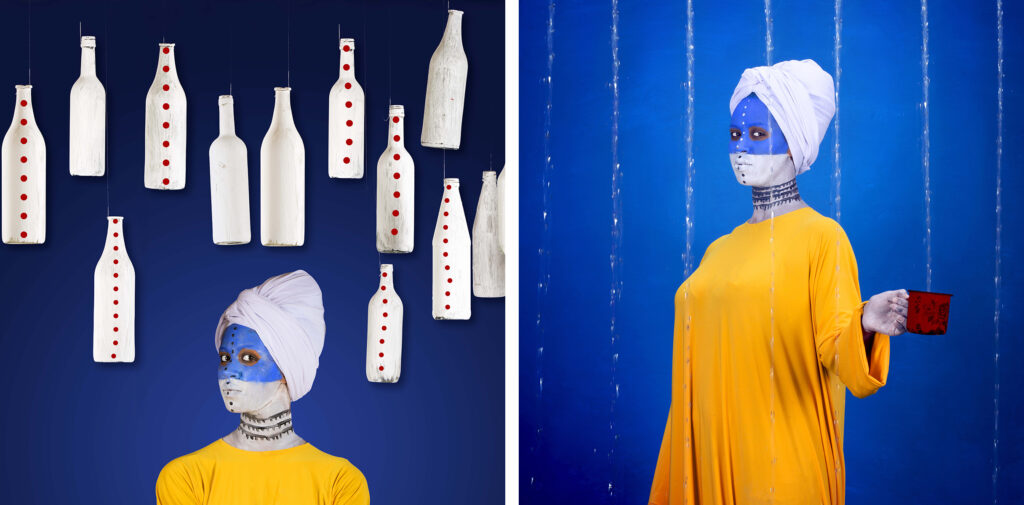
Inside a house, in front of a blue door a woman sits. The composition reminds me of paintings of the virgin Mary in churches. The woman sits in a Madonna-like pose but there is no child. Her lap is empty. And instead of iconic Christian symbols, cleaning tools surround her, in this piece titled, A woman’s work. The jebena, the Ethiopian coffee pot on the ground represents the woman’s traditional role. The broom shows her responsibility to keep the house clean. In the window on the right sits another version of her, turning our attention to the outside, that also has to be taken care of by women. She looks longingly through a window that opens to the sky on the left side with a promise of a better future. We can only hope that it won’t be another unfulfilled promise.
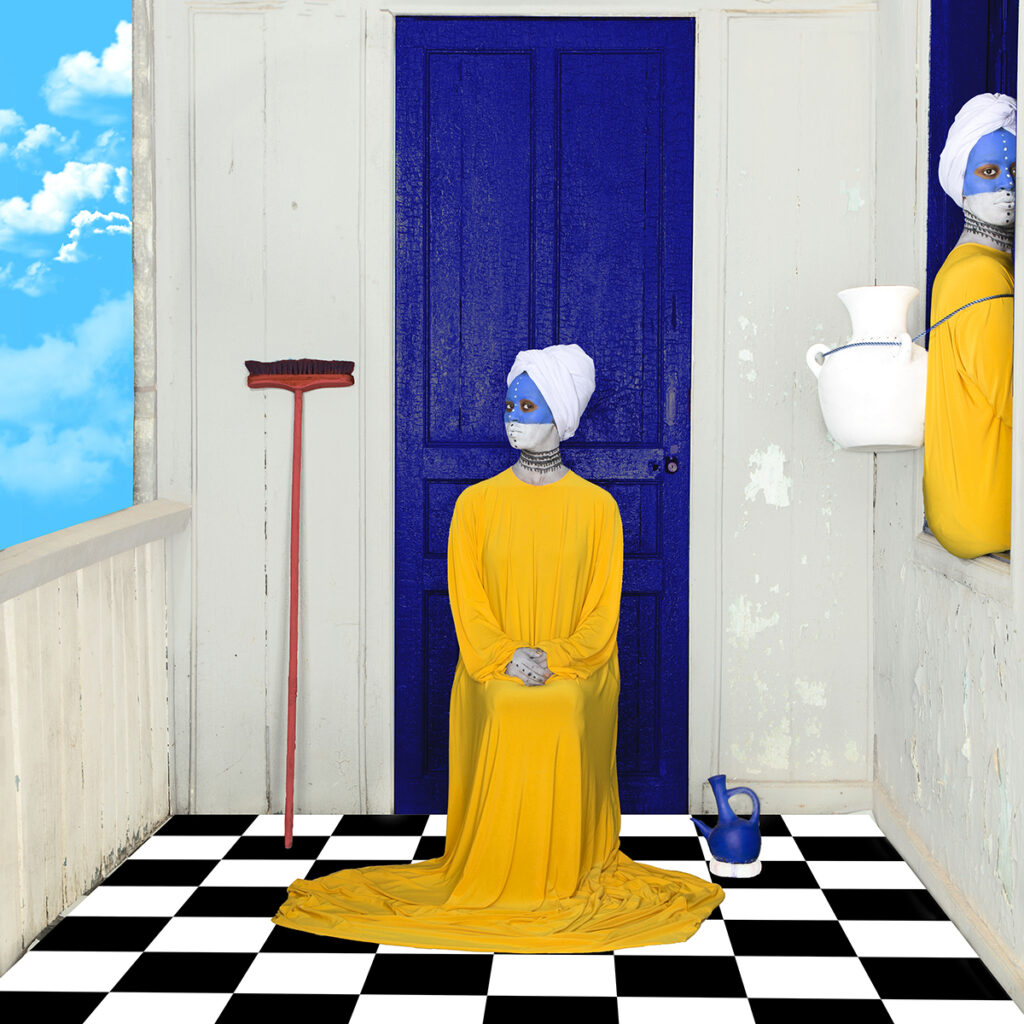
The woman from the window with the clay water pot (an insera) tied to her back reappears in Beside the door. A better dressed woman with some authority stands in front of the door watching the two women carrying clay water pots, their backs arched, and exhausted, they must make their way back and forth to the water source so many times – and it is not over yet. It hits us strongly that these women work very hard, and their work requires lots of strength and sacrifice; the last being strongly encouraged by religion. Muluneh, as part of a family of mixed religions that include both Christian and Muslim, stated that for her, religion is not a practice, it is a culture and a way of life. She uses imagery from both religions as her photographs are heavily influenced by both cultures. Her colours and some compositions are inspired by paintings in orthodox Christian churches, while the landscapes, customs and most of the motifs comes from her Ethiopian Muslim background.
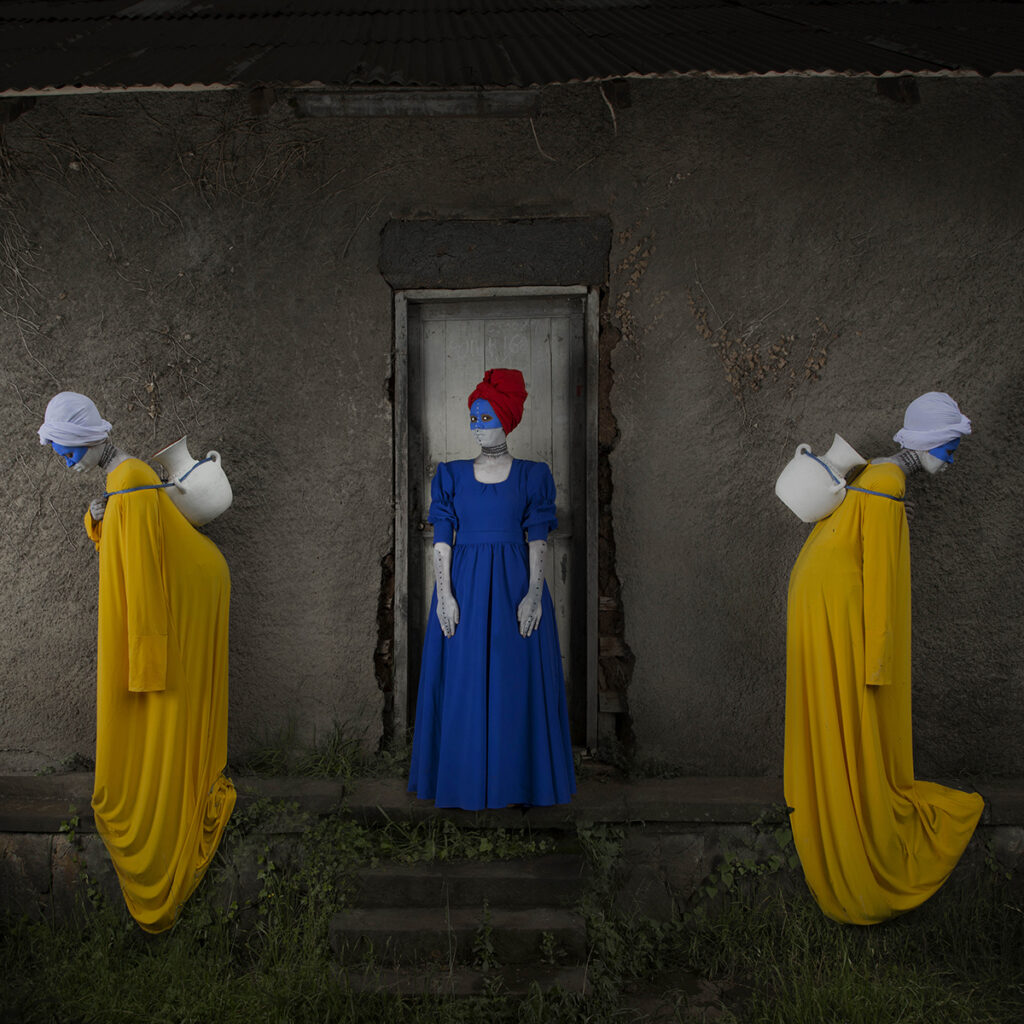
We are amazed by the rich and beautiful garments the women wear in the photographs. The inspiration comes from traditional regional Ethiopian dresses. They are all bright coloured: red, blue or yellow but differ slightly depending on the social status of the women who wear them. It seems that women having higher status can leave their necks and arms uncovered, while poorer, rural women are covered from neck to toe. All their heads are covered. Their bodies are painted but I see a little more in those colours than just traditional ornamentation. Many women have painted the top half of their faces in dark blue with white in the remaining area. I see two worlds combined in it, as Muluneh was born in Africa and grew up in Canada; a meeting of black and North American cultures; building a bridge between them. As the artist stated in her tour, that being an African means that there are complex layers in them, different interpretations, but at the same time at the core their roots and heritage and their culture are really deep in them and that is what she really wants to celebrate. It doesn’t mean that she focuses on the past. She considers cultures as evolving entities, having an open window into the future as well. Afro-futurism, a hope for a better future is always an important element in her work.
I was glued to the ground in front of the radiant, decorative qualities of another beautiful, staged photograph, Star Shine, Moon Glow. I found it challenging to understand its many layers, the universal and the actual, region related meanings. Like all the others, it is an illusionary composition. The landscape is a desert one with rocks and sand covering everything, a place not suitable for humans. Still a young girl sits in the middle of it. She is looking to the left, into an unseen far distance that I interpreted as her wish to be somewhere else. The white stripes on the road in front of her, that almost hurt my eyes, are leading in a different direction. Still, she sits. There is a huge full moon above the sand and rock in the middle of the background, a scary one, too close to the Earth. She sits there with an extremely strong presence that comes mainly from the bright primary colors with which she has been depicted. The blue of her dress is contrasted by the red wings. Those wings are huge and I connect with them easily. When I was a young teenager, we wanted to fly, high up over the mountains, up into the sky, so, along with my cousins, we started to construct wings, following Leonardo da Vinci’s drawings. We’d steal the metal wires and canvases we needed to accomplish making them, but we were discovered and stopped before attempting flight, so after a good beating our wings were taken away, both literally and symbolically. So, looking at those wings, I thought, I understand this. This is her way out. Then, after taking a second look, I recognized how light those wings were, being made of red fabric – no way they can lift anything. They seem more like decorative elements, like butterfly wings. But still, I knew I had missed important elements of this narrative, so I started over. Being a woman, I knew a full moon can represent our monthly cycle, so the red colour might bring blood into the picture. So, this is a girl at the beginning of her womanhood stuck in the middle of a desert. That was the point, confirmed when I decided to read Muluneh’s comment on the work in order to discover the whole story. I learned that girls can’t attend school in Ethiopia when they are menstruating because of the lack of water in bathrooms. The days they miss every month affects their education. So, instead of flying, this girl is a caged bird. She has little chance to walk the striped road either, as she is trapped by the limits of her natural cycle.
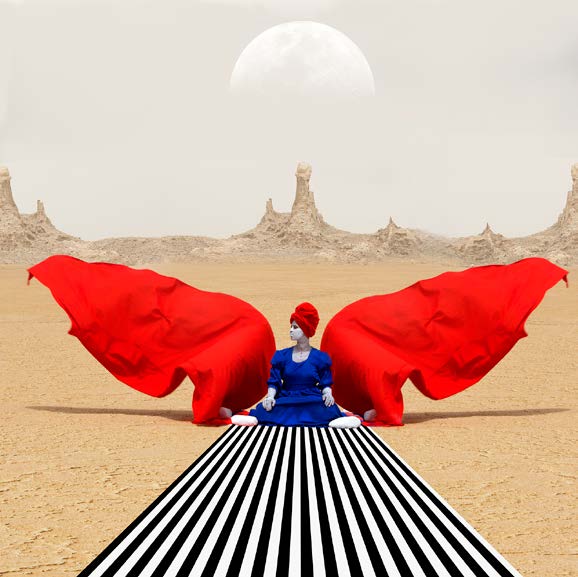
Knowing the way to tomorrow feels to me like a conclusion to the exhibition. The women are still searching for water. In some areas they need to travel a long way to find any. The landscape is a cruel one. The woman in red, carrying the insera, sits on the rock, exhausted. The other woman with the jerrycans stands on the top of the rock and indicates something in the distance — a water well or a better future or both. As Muluneh said about this work, “I assume there must be a glimpse of a thought that she has in the hopes that a better tomorrow will come for those she is caring for.”
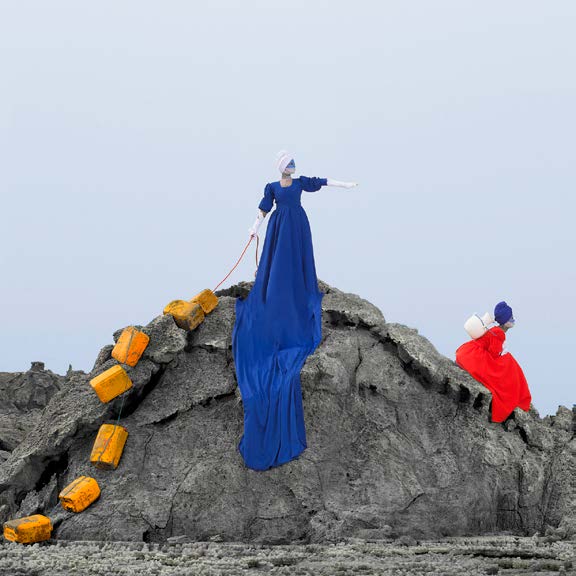
Let’s hope that the road will carry them into new worlds of possibilities. Into a better future, to places with social justice, gender equity and above all – access to water.
Images are courtesy of the artist and the Textile Museum of Canada. The exhibition is open till the end of September, 2022 at the Textile Museum of Canada, 55 Centre Ave, Toronto
